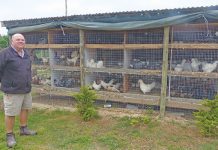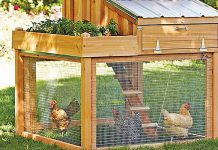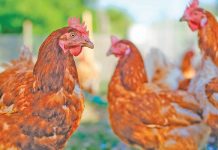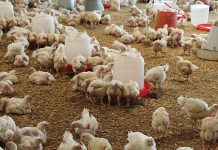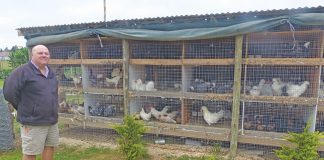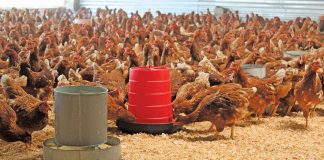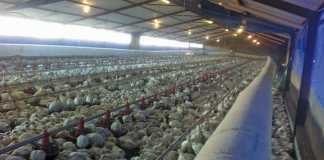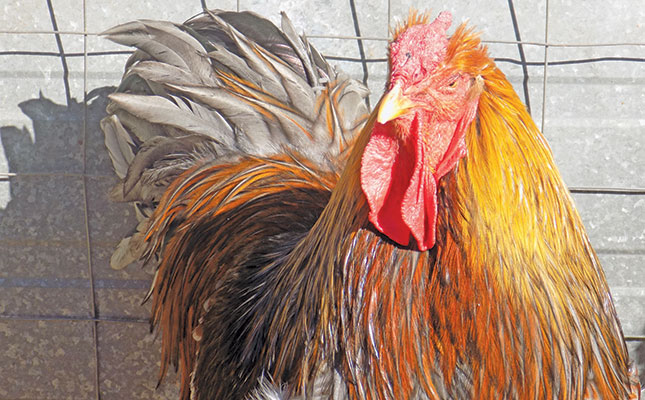
Photo: Annelie Coleman
Nobody could ever accuse Helene Roodt, owner of the Royal Feathers show chicken flock in the Vredefort district, of not properly caring for her chickens and other poultry.
“I’m besotted with my poultry. If I didn’t have an individual relationship with each one, it would be difficult to perform well in the show ring.
Some people’s opinions of chickens are that they’re dim-witted, but I believe they’re intelligent and sensitive animals that know exactly what is expected of them in a show,” she says.
Following the termination of her dog-breeding business about six years ago, Roodt considered a number of new options, but settled on breeding show chickens because, as she puts it, she wanted to farm something that she could cuddle and hug. And what was initially just a hobby for her has since become a full-time job.
A significant investment
Show chicken breeding is a surprisingly complex and capital-intensive concern. Good-quality hens trade for between R700 and R1 200 each, and the Wyandotte and Speckled Sussex are the most popular, selling for around R1 000 each, according
to Roodt. It costs her about R600 to raise one show chicken to point of lay at six to seven months old, and their eggs sell for up to R80 each.
Roodt has an extended clientele base in South Africa and has also exported birds to Botswana.“These days I seldom, if ever, buy in new chickens, as it’s risky bringing birds in from the outside. Over the years, I’ve established my own bloodlines and prefer to take these genetics forward. The development of new colours and colour combinations takes time and extreme attention to detail, and years of selection can be lost in one breeding season by introducing poor-quality genetics,” she explains.
The Brahma and Sussex
The Royal Feathers flock consists of five large breeds, including the Brahma. This breed can be described as a large bird of up to 80cm tall, with a long and broad body. The roosters weigh about 5,5kg, while the hens tend to be smaller, weighing up to 4,5kg.
The Brahma’s distinguishing features include a small pea comb and an overhanging ‘beetle brow’ forehead.
It also has a medium-sized wattle, reddish-brown eyes, a short tail, yellow shanks and feet, red earlobes, and a yellow beak that’s short and strong. Its feet are also feathered.
Brahmas come in a variety of colours, but Roodt currently shows only Dark Brahmas. However, she has made good progress in establishing the Silver Double Laced Brahma variety and intends showing them as soon as possible.
According to the Southern African Show Poultry Organisation’s rules, a breeder is required to show a new colour combination for three consecutive years before he or she can register it. Speckled and light members of the Sussex breed also form part of Roodt’s flock of large breeds. “The Sussex chicken is an alert, calm and highly adaptable breed. It’s also easy to handle and extremely affectionate,” she says.
The Speckled Sussex chicken was named after its spotted plumage. It has a single red comb, and its ears and wattles are also red. The hens weigh in at about 3kg and roosters at around 4kg. A Speckled Sussex of a high standard should have a flat and broad back and a deep chest.
The website poultrykeeper.com describes the base colour of the bird’s plumage as mahogany. According to the official breed standards, the skin, feet and legs should be white. The Light Sussex has a white body and a black tail, its wings are tipped with black, and its neck is white with a black ‘collar’, giving it a striking appearance.
The hens weigh around 3kg and the roosters about 3,2kg. The Wyandotte Roodt’s selection of smaller breeds includes Wyandottes. They come in a wide array of colours, but Roodt’s flock is limited to the Silver Laced, Blue Laced Silver, Gold Laced, Splash Blue Laced Gold, Splash Laced Gold and Silver Double Laced varieties.
She is, however, is in the process of developing another colour variant, the White Laced Red. Roodt says the Wyandotte is a medium-sized bird with a rose comb; long, clean, yellow legs; and broad, loosely fitting feathers. This is Roodt’s favourite breed, and she admits that a hen called Spice is her most-loved bird of all those in her flock. Spice and a rooster called Blixem were the very first two Wyandottes she bred on her own.
As Nice as Spice
In 2019, shortly before Roodt’s most treasured hen was scheduled to take part in a show, she was seriously injured when a small gate toppled over onto her. Roodt says that although she was overcome with worry, she decided to use her tried-and-trusted home remedy in an effort to save the chicken.
The concoction, which consists of turmeric, ginger, cinnamon, cayenne pepper, black pepper and oregano, was duly administered to the chicken. Roodt’s husband, Chris, was quite sceptical about the bird’s prognosis, and even said that with all the spices in her, she was ready for the oven! However, within a day or two, the injured chicken had made a full recovery, and it was this incident that led to the hen being called Spice.
“My birds have, over the years, excelled in shows and have been judged as best in breed and best in variety so many times that I can scarcely keep track of all the awards. However, Spice taking home the best in the category for Splash Laced Gold Wyandottes at the 2019 South African Show Poultry Championships remains the highlight of my career so far,” says Roodt.
Not chickens alone
Apart from a variety of chicken breeds, the Royal Feathers flock also consists of a variety of waterfowl and pigeons. The waterfowl include Bar-headed, Sebastopol and Chinese silver geese, as well as a host of duck breeds such as Carolina, Mandarin and Crested ducks. A pair of mute swans called Charles and Dianna, and a pair of Coscoroba swans by the names of Koos and Koba, also call the Royal Feathers menagerie home. Roodt’s pigeon flock contains seven breeds, of which the Jacobin is the rarest.
Nutrition, health and management
Roodt feeds her chickens commercial feed supplemented with maize and sunflower seeds, and the hens also receive layer pellets. Additional maize is supplied in winter for increased energy. She believes in the value of fresh vegetables, and gives them to her chickens on a daily basis.
This ration includes all vegetables, except potatoes which, according to Roodt, do not agree with the birds for some reason. Pumpkin, on the other hand, is particularly good for the birds, because the seeds act as a natural dewormer. In addition, the brew that Roodt believes helped nurse Spice back to health is sprinkled over the vegetables before they’re fed to the chickens.
The Royal Feathers birds are vaccinated annually against Newcastle disease after the brooding period. Roodt does not vaccinate against fowl pox, a viral disease of chickens characterised by lesions on the unfeathered skin areas (dry pox) and/or the mucous membranes of the oral cavity, larynx, and trachea (wet pox), but she does treat any outbreaks as needed.
“Fowl pox is carried by insects such as gnats and mosquitoes, and is caused by the same virus that causes bluetongue in sheep,” she says. Chickens suffering from wet pox receive antibiotics, while cases of dry pox are treated with black shoe polish and toothpaste. Roodt only uses Colgate toothpaste as, in her experience, it is more effective than other brands.
She uses black shoe polish because the colour protects the affected birds from being pecked by the rest of the flock. The respective breeds are kept apart from each other in small groups (usually four hens to a rooster), in 3m x 3m pens for effective management. Roodt’s hands-on approach to managing her chickens also aids in the timeous identification of any disease outbreaks, and allows her to keep abreast of the general condition of the flock, she says.
Email Helene Roodt at [email protected].

